Finding the right car insurance can be a daunting task, especially when you’re on a budget. In the US, having affordable car insurance is crucial for financial security and peace of mind.
Navigating through various US car insurance options can be overwhelming, but it’s essential to understand that the right coverage at the right price is within reach. By comparing rates, understanding policy details, and leveraging discounts, you can secure affordable car insurance that meets your needs.
Key Takeaways
- Compare rates from multiple providers to find the best deal.
- Understand the different types of coverage and what they offer.
- Leverage discounts for safe driving, student status, or bundling policies.
- Review and adjust your policy annually to ensure it’s still right for you.
- Consider working with an insurance broker for personalized advice.
The Importance of Car Insurance in the United States
Understanding the importance of car insurance is crucial for drivers across the US, as it offers both legal and financial safeguards. Car insurance is not just a legal requirement in most states, but it also provides a financial safety net against accidents, theft, and other unforeseen events.

Legal Requirements Across Different States
Car insurance laws vary significantly across different states in the US. While some states require drivers to have a minimum level of liability coverage, others may have additional requirements such as personal injury protection (PIP) or uninsured motorist coverage. For instance, states like Michigan and New Jersey have unique requirements due to their no-fault insurance systems. Drivers must understand their state’s specific requirements to avoid fines and penalties.
Financial Protection Benefits
Car insurance provides substantial financial protection benefits, shielding drivers from the potentially devastating costs associated with vehicle accidents or damage. Liability coverage helps pay for damages to others if you’re at fault in an accident, while collision coverage and comprehensive coverage protect your vehicle against various types of damage. As Warren Buffett once said, “Price is what you pay. Value is what you get.” Car insurance offers value by providing financial security and peace of mind.
“The biggest risk is not taking any risk…” – Mark Zuckerberg
In the context of car insurance, taking the risk of being uninsured or underinsured can have severe financial consequences. Adequate insurance coverage mitigates this risk.
Essential Insurance Terminology
Understanding key insurance terminology is vital for making informed decisions about your car insurance. Terms like deductible, premium, and policy limits are fundamental to grasping how insurance works. A deductible is the amount you pay out of pocket before your insurance kicks in, while a premium is the regular payment you make to maintain your coverage. Policy limits refer to the maximum amount your insurance company will pay for a covered loss.
Types of Car Insurance Coverage Options
When it comes to car insurance, knowing the different types of coverage can help you choose the best policy for your situation. Car insurance is designed to protect you financially in the event of an accident or other damage to your vehicle. The various types of coverage can be mixed and matched to create a policy that suits your needs.
Liability Coverage: Bodily Injury and Property Damage
Liability coverage is a fundamental component of car insurance, as it covers damages to others in an accident. This includes bodily injury liability, which pays for medical expenses, lost wages, and other related costs for people injured in the accident, and property damage liability, which covers repairs or replacement of damaged property.
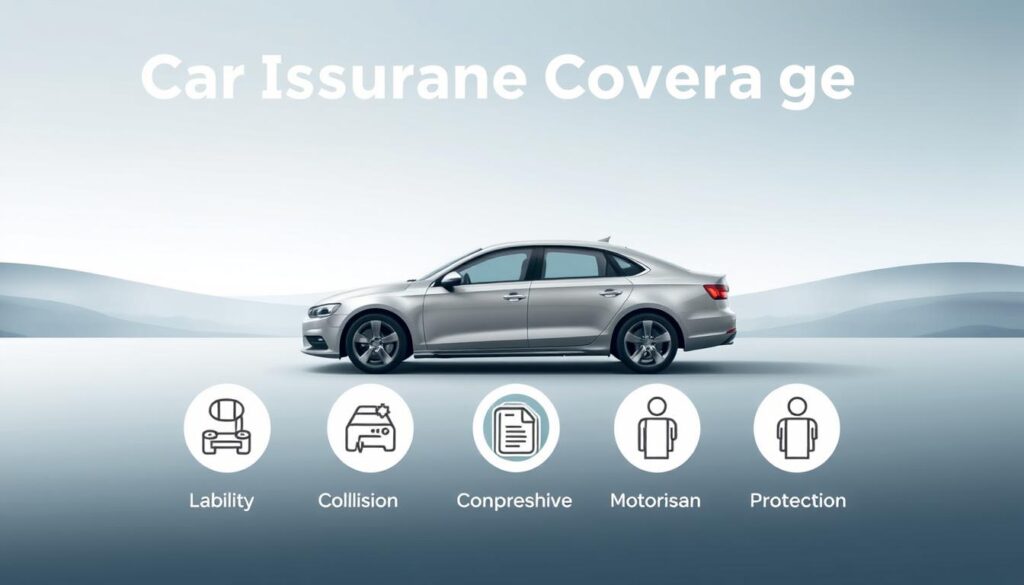
Collision and Comprehensive Coverage
Collision coverage pays for repairs to your vehicle if you’re involved in an accident, regardless of who’s at fault. Comprehensive coverage, on the other hand, covers damages not related to accidents, such as theft, vandalism, or natural disasters. Both types of coverage are optional but provide significant financial protection.
Personal Injury Protection and Medical Payments
Personal Injury Protection (PIP) and Medical Payments coverage help pay for medical expenses for you and your passengers, regardless of fault. PIP often covers additional costs like lost wages and childcare.
Uninsured/Underinsured Motorist Coverage
This coverage protects you if you’re involved in an accident with someone who doesn’t have insurance or doesn’t have enough insurance to cover the damages.
Additional Coverage Options
Other coverage options include roadside assistance, rental car coverage, and gap insurance. These can provide additional peace of mind and financial protection in various situations.
Key Factors That Influence Car Insurance Rates
The cost of car insurance is not arbitrary; it’s calculated based on several key factors that insurers consider when determining premiums. Understanding these factors can help you make informed decisions to potentially lower your car insurance rates.
Driving History and Claims Record
Your driving history is a significant factor in determining your car insurance rates. A clean driving record with no accidents or tickets generally results in lower premiums. Conversely, a history of claims or traffic violations can increase your rates. Insurers view drivers with a history of incidents as higher risk, leading to higher premiums.
Vehicle Make, Model, and Safety Features
The type of vehicle you drive also impacts your insurance rates. Vehicles with advanced safety features, such as lane departure warning systems and automatic emergency braking, may qualify for lower rates. On the other hand, high-performance or luxury vehicles are typically more expensive to insure due to higher repair or replacement costs.
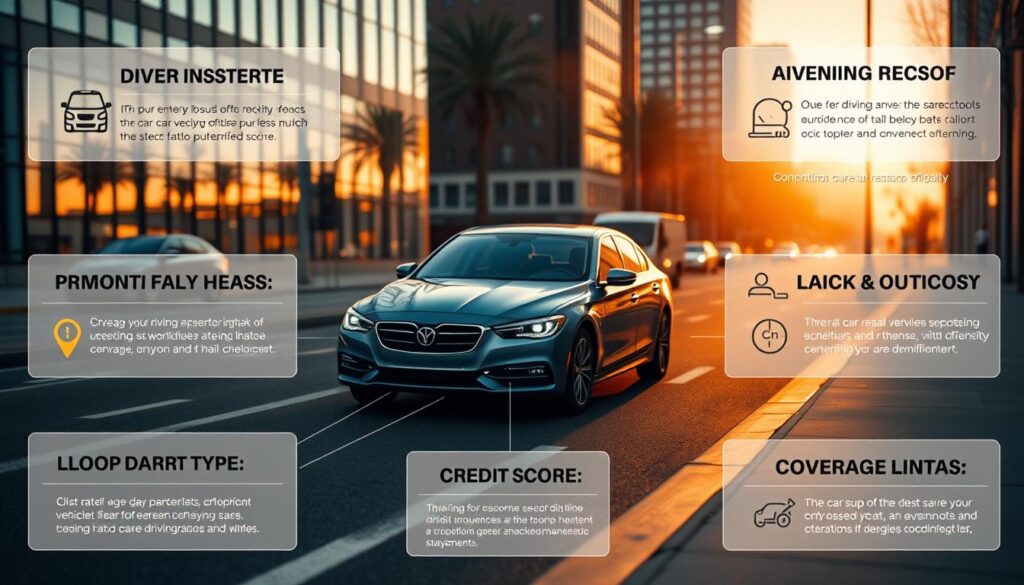
Geographic Location and Local Risk Factors
Where you live plays a crucial role in determining your car insurance rates. Areas with high crime rates, heavy traffic, or prone to natural disasters may have higher premiums. Insurers assess local risk factors, including the likelihood of accidents, theft, or vandalism, when calculating your rates.
Credit-Based Insurance Scores
In many states, insurers use credit-based insurance scores to help determine premiums. A good credit score can lead to lower car insurance rates, as it indicates to insurers that you’re more likely to pay your premiums on time and less likely to file claims.
Demographic Factors: Age, Gender, and Marital Status
Demographic factors such as age, gender, and marital status can also influence your car insurance rates. For instance, younger drivers and males are often charged higher premiums due to statistically higher risk profiles. Married individuals, however, may benefit from lower rates as they are considered more stable.
Finding the Right Balance of Coverage and Cost
The challenge of securing car insurance that offers both sufficient coverage and reasonable pricing is a common concern. Drivers need to navigate through various options to find a policy that meets their needs without breaking the bank.
Minimum Requirements vs. Recommended Protection
Understanding the minimum car insurance requirements in your state is essential, but it’s equally important to consider recommended protection levels. While the law may require only liability coverage, adding comprehensive and collision coverage can provide additional financial protection against vehicle damage or theft.
Comparison of Minimum and Recommended Coverage
| Coverage Type | Minimum Requirement | Recommended Protection |
|---|---|---|
| Liability Coverage | State Minimum | Higher Limits for Adequate Protection |
| Comprehensive Coverage | Not Required | Recommended for New or Luxury Vehicles |
| Collision Coverage | Not Required | Recommended for Vehicle Owners |
Assessing Your Personal Risk Tolerance
Assessing your personal risk tolerance plays a significant role in determining the right balance of coverage and cost. Drivers with a higher risk tolerance might opt for lower premiums with higher deductibles, while those with a lower risk tolerance may prefer more comprehensive coverage.

By understanding your financial situation, driving habits, and personal preferences, you can make an informed decision about your car insurance coverage.
Major Car Insurance Companies in America
Car insurance in the US is provided by a mix of national, regional, and specialty insurers, catering to diverse customer needs and preferences. Understanding the key players in this market can help consumers make informed decisions when selecting a car insurance provider.
Top-Rated National Providers
National providers are known for their extensive reach and comprehensive coverage options. Companies like State Farm, Geico, and Progressive are among the top-rated insurers, offering a wide range of policies that cater to different demographics and driving histories.
These companies are recognized for their financial stability, customer service, and innovative insurance products. For instance, Geico is known for its competitive pricing, while Progressive is praised for its usage-based insurance options.

Regional and Specialty Insurers
Regional insurers often provide more personalized services and may offer policies tailored to specific local conditions. Companies like Amica Mutual and USAA are highly regarded for their customer satisfaction and specialized coverage options. USAA, for example, caters specifically to military personnel and their families.
Specialty insurers focus on niche markets, such as high-risk drivers or collectors’ vehicles, providing coverage that larger companies may not offer.
Budget-Friendly Insurance Companies
For drivers on a tight budget, companies like Root Insurance and Esurance offer affordable car insurance options. These insurers leverage technology to streamline their operations and pass the savings on to customers.
Budget-friendly insurers often provide basic coverage at competitive rates, making car insurance more accessible to a wider audience.
| Insurer | Key Feature | Target Market |
|---|---|---|
| State Farm | Comprehensive coverage options | General consumers |
| Geico | Competitive pricing | Budget-conscious drivers |
| USAA | Specialized coverage for military personnel | Military families |
| Root Insurance | Usage-based insurance | Safe drivers |
How to Compare Car Insurance Quotes Effectively
To secure the most suitable car insurance, understanding how to compare quotes effectively is essential. With numerous insurance providers in the US, each offering various coverage options and pricing, comparing quotes can be overwhelming. However, by leveraging the right tools and strategies, you can simplify this process and make an informed decision.
Online Comparison Platforms and Tools
Online comparison platforms have revolutionized the way we shop for car insurance. Websites and apps allow you to input your details once and receive multiple quotes from different insurers. This not only saves time but also gives you a clear view of the market. Utilizing online comparison tools can help you identify the most competitive rates and coverage options tailored to your needs.
Benefits of Working with Independent Agents
Independent insurance agents can offer personalized advice and access to multiple insurance carriers. They can help you navigate complex insurance jargon and identify the best policies for your situation. Working with an independent agent can be particularly beneficial if you have unique insurance needs or prefer a more personalized service.
Evaluating Coverage, Service, and Financial Stability
When comparing car insurance quotes, it’s crucial to look beyond the premium costs. Evaluating the coverage details, customer service reputation, and financial stability of the insurer is vital. A comprehensive comparison should include:
| Criteria | Description | Importance Level |
|---|---|---|
| Coverage Options | Range of coverage types and limits | High |
| Customer Service | Reputation for handling claims and queries | High |
| Financial Stability | Insurer’s ability to pay out claims | High |
| Premium Costs | Cost of the insurance policy | Medium |
By considering these factors and using a combination of online tools and professional advice, you can effectively compare car insurance quotes and find the best coverage for your needs.
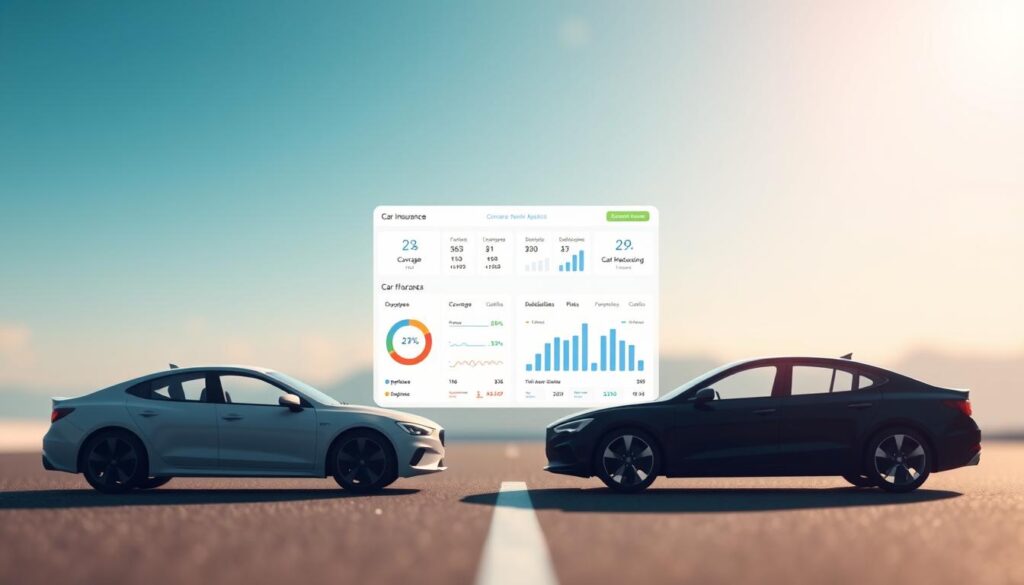
Understanding State-Specific Car Insurance Requirements
State-specific car insurance requirements are a critical aspect of driving legally and safely in the United States. Each state has its own set of regulations regarding car insurance, making it essential for drivers to understand these requirements to avoid legal and financial repercussions.
No-Fault vs. At-Fault Insurance Systems
The US car insurance system is broadly categorized into two types: no-fault and at-fault insurance systems. In no-fault states, drivers are required to carry insurance that covers their own expenses regardless of who is at fault in an accident. Currently, 12 states follow a no-fault system. On the other hand, at-fault states require drivers to determine who is at fault in an accident to assign financial responsibility for damages.
Minimum Coverage Requirements by Region
Minimum car insurance coverage requirements vary significantly across states. The following table illustrates the minimum liability coverage required in several states:
| State | Bodily Injury Liability per Person | Bodily Injury Liability per Accident | Property Damage Liability |
|---|---|---|---|
| California | $15,000 | $30,000 | $5,000 |
| New York | $25,000 | $50,000 | $10,000 |
| Texas | $30,000 | $60,000 | $25,000 |
This table highlights the diversity in minimum coverage requirements, emphasizing the need for drivers to familiarize themselves with their state’s specific regulations.
State Insurance Programs for High-Risk Drivers
Many states have programs in place for high-risk drivers who are unable to secure insurance through the standard market. These programs, often referred to as assigned risk pools or high-risk insurance pools, provide an avenue for high-risk drivers to obtain necessary coverage, albeit often at a higher premium.
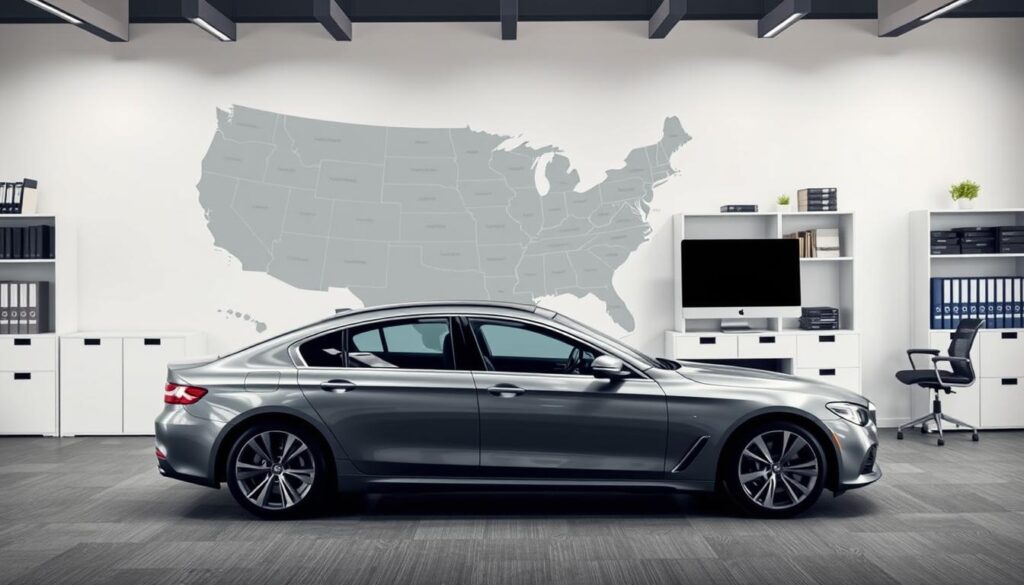
Maximizing Car Insurance Discounts and Savings
To save on car insurance, it’s essential to explore available discounts. Insurance companies offer various discounts that can significantly reduce your premiums. By understanding and leveraging these discounts, you can lower your car insurance costs without compromising on coverage.
Multi-Policy and Multi-Vehicle Bundling
One of the most effective ways to save on car insurance is by bundling multiple policies or insuring multiple vehicles with the same provider. Multi-policy discounts can be substantial, often ranging between 10% to 20% off your premiums. Similarly, insuring multiple vehicles under one policy can lead to significant savings.
Safe Driver and Low Mileage Programs
Being a safe driver can pay off. Many insurance companies offer safe driver discounts to drivers with a clean driving record. Additionally, low mileage programs reward drivers who drive fewer miles than average, as they are considered less risky.
Educational and Occupational Discounts
Certain educational achievements and occupations can qualify you for discounts. For instance, some insurers offer discounts to students with good grades or to professionals in specific fields. It’s worth inquiring about such discounts when shopping for insurance.
Vehicle Safety and Anti-Theft Discounts
Vehicles equipped with advanced safety features or anti-theft devices can qualify for additional discounts. Features like lane departure warning systems, blind-spot detection, and GPS tracking devices can make your vehicle less risky to insure.
Payment and Loyalty Rewards
Some insurers reward customers for paying their premiums in full upfront or for being long-term customers. These loyalty rewards can provide additional savings over time.
To maximize your savings, it’s crucial to discuss these options with your insurance provider and understand the specific discounts you’re eligible for.
| Discount Type | Description | Potential Savings |
|---|---|---|
| Multi-Policy Bundling | Bundling multiple insurance policies with one provider | 10%-20% off premiums |
| Safe Driver | Having a clean driving record | Up to 30% off premiums |
| Low Mileage | Driving fewer miles than average | 5%-15% off premiums |
| Educational/Occupational | Specific educational achievements or occupations | Varies by insurer |
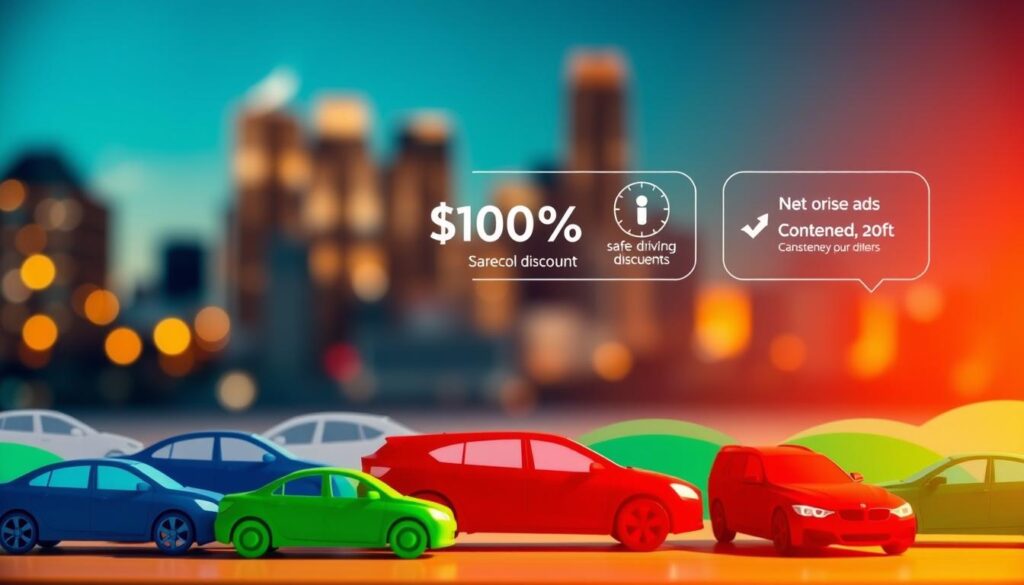
Proven Strategies to Lower Your Car Insurance Premium
Car insurance premiums can be significantly lowered by implementing a few key strategies. By understanding and adjusting the factors that influence your insurance costs, you can achieve substantial savings over time.
Strategic Deductible Adjustments
One effective way to lower your car insurance premium is by adjusting your deductible. A higher deductible means you’ll pay more out-of-pocket in the event of a claim, but it can significantly reduce your premium. It’s essential to strike a balance between a deductible that’s high enough to lower your premium and low enough to be manageable in case of a claim.
Credit Score Improvement Tactics
Improving your credit score can also lead to lower car insurance premiums, as many insurers use credit-based insurance scores to determine rates. By maintaining a good credit history, paying bills on time, and reducing debt, you can improve your credit score and potentially lower your insurance costs.

Defensive Driving Certification Benefits
Taking a defensive driving course can not only make you a safer driver but also qualify you for discounts on your car insurance. Many insurance providers offer reductions for drivers who complete such courses, as they are seen as less of a risk.
Annual Policy Review Best Practices
Reviewing your car insurance policy annually is crucial to ensure you’re not over-insured or under-insured. This review can help you adjust your coverage levels, take advantage of new discounts, and lower your premium.
Vehicle Selection Considerations
The type of vehicle you drive can significantly impact your car insurance premium. Vehicles with advanced safety features, lower theft rates, and lower repair costs tend to have lower insurance premiums. Considering these factors when purchasing a vehicle can lead to long-term savings on your insurance.
| Strategy | Potential Savings | Implementation Effort |
|---|---|---|
| Deductible Adjustments | Up to 30% | Low |
| Credit Score Improvement | Up to 20% | Medium |
| Defensive Driving Courses | Up to 15% | Low |
| Annual Policy Review | Up to 10% | Low |
| Vehicle Selection | Up to 25% | High |
Common Car Insurance Shopping Mistakes to Avoid
Car insurance shopping is fraught with potential mistakes that can leave you vulnerable to significant financial risks. To navigate this complex process effectively, it’s crucial to be aware of the common pitfalls that many consumers encounter.
Prioritizing Price Over Coverage Quality
One of the most significant mistakes is prioritizing the price of the insurance policy over the quality of coverage. While cost is an important factor, opting for the cheapest policy can result in inadequate protection when you need it most. It’s essential to balance affordability with comprehensive coverage.
Coverage Gaps and Inadequate Protection
Another critical error is failing to identify coverage gaps. This can happen when policyholders misunderstand what their policy covers or neglect to update their coverage as their circumstances change. Ensuring that your policy provides adequate protection against various risks is vital.
| Common Coverage Gaps | Description | Potential Impact |
|---|---|---|
| Lack of Comprehensive Coverage | Not having coverage for damages not caused by collisions. | Financial loss due to theft, vandalism, or natural disasters. |
| Insufficient Liability Coverage | Having inadequate coverage for bodily injury or property damage to others. | Legal and financial repercussions in case of an accident. |
Inaccurate Application Information
Providing inaccurate information on your insurance application is another mistake that can have serious consequences. This can lead to policy cancellations or claims being denied. It’s crucial to ensure that all details provided are accurate and up-to-date.
By being aware of these common car insurance shopping mistakes, you can make more informed decisions and avoid potential financial pitfalls. Taking the time to carefully review your options and understand your policy can provide peace of mind and financial security.
Navigating the Car Insurance Claims Process
When it comes to car insurance claims, knowing the right steps to take can help ensure a smooth and efficient experience. The process involves several key stages, from initial documentation to resolving any disputes that may arise.
Post-Accident Documentation Steps
After an accident, it’s crucial to document everything thoroughly. This includes taking photos of the damage, noting the time and location of the incident, and gathering witness statements if available. Proper documentation is essential for supporting your claim.
Efficient Claim Filing Procedures
Filing a claim efficiently requires attention to detail. Ensure you have all necessary documents, including your policy number, details of the incident, and any supporting evidence. Submitting a complete and accurate claim helps prevent delays.
Resolving Claim Disputes and Denials
If your claim is disputed or denied, understanding your options is vital. You can appeal the decision or negotiate with your insurer. Knowing your rights and the claims process can help resolve disputes effectively.
By following these steps and being informed, you can navigate the car insurance claims process more effectively, ensuring you receive the compensation you’re entitled to.
Special Car Insurance Considerations for Different Drivers
Different drivers have unique car insurance requirements and challenges. Whether you’re a new driver, a senior, or someone with a less-than-perfect driving record, understanding your specific needs is crucial for securing the right coverage.
New and Young Driver Options
New and young drivers often face higher insurance premiums due to their limited driving experience. However, many insurance companies offer discounts for good grades or completion of defensive driving courses. For instance, drivers under 25 can benefit from usage-based insurance that monitors their driving habits and rewards safe behavior.
Senior Driver Discount Programs
Senior drivers can also benefit from various discount programs. Many insurers offer mature driver discounts for completing a defensive driving course or for being a member of certain organizations. These discounts can significantly reduce premiums without compromising on coverage.
Solutions for Drivers with Poor Records
For drivers with poor records, there are specialized insurance solutions. Some insurers specialize in high-risk driver insurance, providing coverage to those who have been denied by standard insurers. Improving driving habits and taking corrective courses can also help in reducing premiums over time.
Commercial and Rideshare Coverage
Drivers working for rideshare companies or operating commercial vehicles require specific types of insurance coverage. Rideshare insurance fills the gap between personal auto insurance and the coverage provided by the rideshare company. Commercial insurance, on the other hand, covers vehicles used for business purposes, protecting against liability and property damage.
Specialty Vehicle Insurance
Owners of specialty vehicles, such as classic cars or high-performance vehicles, need tailored insurance coverage. These policies often include agreed value coverage, ensuring that the vehicle’s full value is covered in case of a total loss.
Here’s a comparison of different insurance options for various driver profiles:
| Driver Profile | Insurance Needs | Potential Discounts |
|---|---|---|
| New/Young Drivers | Higher coverage limits, possibly usage-based insurance | Good grade discounts, defensive driving course discounts |
| Senior Drivers | Mature driver programs, potential for lower coverage limits | Mature driver discounts, membership discounts |
| Drivers with Poor Records | High-risk insurance, SR-22 if required | Improving driving record, defensive driving courses |
| Rideshare/Commercial Drivers | Rideshare insurance, commercial insurance | Multi-policy discounts, safe driving discounts |
| Specialty Vehicle Owners | Agreed value coverage, specialized coverage options | Multi-vehicle discounts, membership discounts |
Technology Innovations in Car Insurance
The integration of technology in car insurance is enhancing customer experience and operational efficiency. This transformation is driven by various technological innovations that are changing the way insurance is bought, managed, and claimed.
Usage-Based Insurance and Telematics
Usage-based insurance (UBI) and telematics are revolutionizing the car insurance industry by offering personalized premiums based on actual driving behavior. This approach not only rewards safe drivers with lower premiums but also helps insurers to more accurately assess risk.
Mobile Apps and Digital Policy Management
Mobile apps are becoming increasingly popular for managing car insurance policies. They allow customers to easily access their policy details, make payments, and file claims on the go. This digital convenience is enhancing customer satisfaction and reducing administrative costs for insurers.
AI and Automated Claims Processing
The use of Artificial Intelligence (AI) in claims processing is significantly reducing the time taken to settle claims. AI algorithms can quickly assess damage and determine the validity of claims, leading to faster payouts and improved customer experience.
These technological advancements are not only improving operational efficiency but also enabling car insurance companies to offer more competitive and tailored products to their customers.
The Future of Affordable Car Insurance
As the automotive landscape evolves, the future of car insurance is poised to undergo significant transformations. The insurance industry is adapting to technological advancements, changing consumer behaviors, and emerging risks.
Self-Driving Vehicle Coverage Trends
The rise of self-driving vehicles is expected to revolutionize the car insurance industry. With autonomous cars, the risk of accidents may decrease, potentially leading to lower insurance premiums. However, new risks and challenges arise, such as cybersecurity threats and liability concerns in the event of an accident. Insurers are beginning to develop policies that address these unique risks, including coverage for software failures and hacking incidents.
Key trends in self-driving vehicle coverage include the development of specialized policies for autonomous vehicles, adjustments in liability coverage, and the integration of telematics to monitor and manage risk.
Emerging Insurance Models and Structures
The car insurance industry is witnessing the emergence of innovative models and structures designed to better serve policyholders. Usage-based insurance, for instance, allows premiums to be calculated based on actual driving habits, potentially reducing costs for safe drivers. Other emerging models include peer-to-peer insurance and insurance-as-a-service platforms, which offer more flexibility and personalized coverage options.
- Usage-based insurance models
- Peer-to-peer insurance platforms
- Insurance-as-a-service offerings
Environmental Factors Affecting Future Rates
Environmental factors, such as climate change and natural disasters, are increasingly influencing car insurance rates. Insurers are reassessing risk models to account for the growing frequency and severity of weather-related events. This shift may lead to changes in premium pricing, with areas prone to natural disasters potentially facing higher rates.
Insurers are responding by developing more sophisticated risk models that incorporate environmental data, promoting mitigation measures, and offering incentives for policyholders to adopt risk-reducing strategies.
Conclusion: Securing the Best Car Insurance Value
Securing the best car insurance value requires a comprehensive understanding of the various factors that influence car insurance rates and coverage options. By being informed and proactive, drivers in the United States can navigate the complex car insurance landscape effectively.
To achieve the best car insurance value, it’s essential to assess your personal risk tolerance, driving history, and financial situation. This enables you to strike a balance between coverage and cost, ensuring you’re adequately protected without overpaying.
Insurance companies like Geico, Progressive, and State Farm offer a range of coverage options and discounts that can help lower premiums. By leveraging multi-policy discounts, safe driver programs, and other savings opportunities, you can secure car insurance that meets your needs and budget.
Ultimately, securing the best car insurance value involves ongoing effort and attention. Regularly reviewing your policy, staying informed about industry trends, and adjusting your coverage as needed will help you maintain optimal protection and value.

